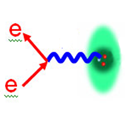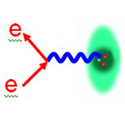Exclusive pions
The particles produced by scattering electrons off nucleons provide important information about the inner workings of the nucleus. At the Thomas Jefferson Lab National Accelerator Facility (JLAB) in the US and the Deutsches Elektronen-Synchrotron (DESY), Germany, these experiments are now being extended to using higher-energy electrons. These measurements will, for example, allow the observation of the production of single (“exclusive”) charged pions (the particles that mediate the strong nuclear force) over a wider range in energy and down to shorter distances.
Existing models are not able to explain all the properties of pion-production data in these high-energy experiments. Now, writing in Physical Review C, Murat Kaskulov and Ulrich Mosel at Universität Gießen in Germany propose a comprehensive description of exclusive charged-pion electroproduction that fits the data over a larger energy range than previously possible. By using duality arguments, Kaskulov and Mosel are able to reproduce both the cross sections measured at JLAB and the higher-energy data measured at DESY.
An important application of this model is that it can accurately extract from experiments the pion’s form factor (a measure of the particle’s shape), which is a quantity that cannot be determined without theoretical input. More generally, this theoretical advance will be useful for future high-energy experiments planned at the upgraded facility at JLAB. –Jessica Thomas





